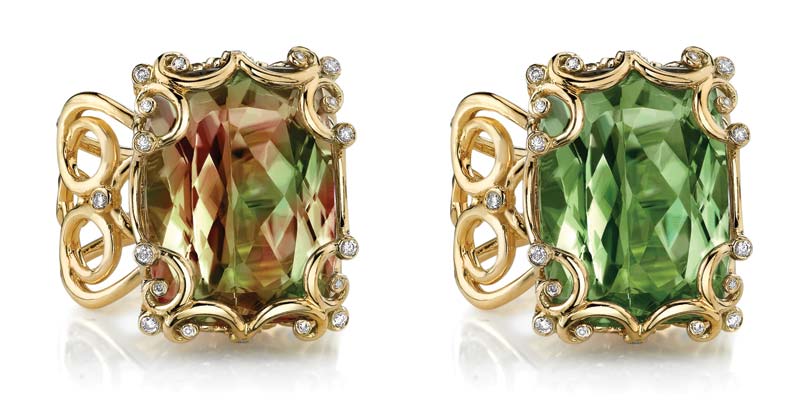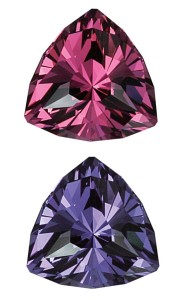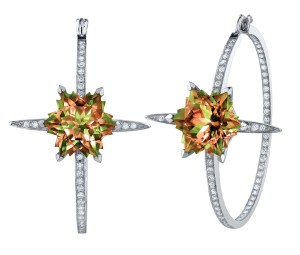Quick-change artist: Colour-change stones rank high on collectors’ must-have lists
by charlene_voisin | December 1, 2013 9:00 am
By Diana Jarrett
 [1]
[1]Coloured gems are gaining traction in haute couture goods, freeing designers to be more adventurous in their stone choices, particularly with high-ticket items. Some of these decisions reflect retailers’ push for better margins after diamond and gold prices skyrocketed. But over time, selling colour has become easier, as consumers are savvier about the inherent value of these bright baubles.
Now colour-change stones are earning top billing, too. They’ve always been cozy with mineral collectors, but jewellery fans are also flaunting them. Gemstones with unusual optical effects are collectively referred to as ‘phenomenal’ gems. They can exhibit cat’s eye, play of colour, or asterism, with its mesmerizing star effect. But the optical effect darlings of today’s designs are those that completely change colour when exposed to natural daylight, incandescent lighting, or fluorescence. The most recognized colour-change gemstone is the pricey alexandrite, a rare variety of chrysoberyl. Other less rare, but highly valued, colour-change stones include fancy sapphire, garnet, spinel, tourmaline, and the gem-quality diaspore known as zultanite.
What’s going on here?
The mechanism behind this mysterious transformation centres on how gemstones absorb light in different environments. “A colour-change gem like alexandrite has two transmission windows,” explains Zak Adourian, owner and research and development director of Qouture, a manufacturer of gemmological instruments based in Los Angeles.
“Under incandescent light, which is rich in red, it reflects or transmits pink. Under fluorescent light, which is rich in green-blue, it reflects green,” Adourian says. “Depending on the gem, LED lighting behaves like mixed lighting. In pink/green gems, the colours blend and the stone appears olive. More research needs to be done to determine how LED lighting affects gems.”
More of these lively stones are penetrating the market, helping retailers and consumers learn to appreciate their traits. Even the pros are sometimes awed. “The most surprising phenomenon I encounter in colour-change stones is not their colours, but the resulting dispersion,” Adourian recalls. (Dispersion, also referred to as fire, occurs when the light that enters a stone splits into all the colours of the rainbow.) “I exposed a 10-carat rectangular alexandrite—which is known to have low dispersion—to direct LED lighting and observed mesmerizing purple, pink, and fuchsia flashes dance in the gem. It was beautiful.”
The same thing, but different
 [2]
[2]An effect called ‘colour shift’ occurs in untreated stones, but it’s not the same thing. “It is important to distinguish colour-change from what is sometimes called colour shift,” explains Bangkok wholesaler, Arnold Silverberg, owner of AJS Gems. “Many gemstones show some degree of colour shift within their hue family under different lighting conditions. Blue sapphire, for example, looks bluer under natural light than [it does] under incandescent lighting because natural light is richer in blue wavelengths. The colour of ruby, on the other hand, is enhanced by incandescent lighting, which is weighted more heavily to frequencies in the red and yellow part of the spectrum.”
Study plenty, then cut
Gem cutters must become expert in each colour-change species to achieve its maximum potential. Vancouver faceter Lisa Elser tells Jewellery Business, “There are a few challenges. Orientation is critical to get the best possible change, plus two good colours from the rough. The material is usually quite expensive, so I must balance colour-change with the stone’s finished carat size. Colour-change gems, in particular red/blue or red/green garnet and Umba sapphires, typically have fine, silky inclusions that can make the finished gem look ‘sleepy’ if I’m not careful.”
Cutting colour-changing stones can become more complicated when the country of origin requires its gems be cut prior to export. “I prefer to cut from my own rough,” Elser shares. “In Sri Lanka, it was impossible to acquire high-quality rough for export. Most of the poorly cut stones would have made good recuts, but were priced far too high to be workable. They may be able to sell a poorly cut stone, but I’d lose too much on a recut.”
Ontario custom cutter Rudi Wobito is known for his artful zultanite creations, which he began cutting in 2004. “In the case of zultanite, the crystals are all highly included and yield only two to two and a half per cent from rough,” he explains. “To get a deeper impression of colour, you need to cut stones with smaller facets and a thicker girdle. [With zultanite’s crystal structure,] you get the strongest colour by cutting at right angles to cleavage planes, yet it’s almost impossible to cut that way. The next best solution is to go one to two degrees off the cleavage plane.” Wobito stresses that with zultanite and other colour-change gems, it’s always a compromise between weight retention and optical effect.
In addition to the extent of colour-change expressed as a percentage of the entire stone, the attractiveness of the gem’s two distinct colours is the most important component regarding value. These colour changes are infinitely repeatable, giving the wearer and admirer a visual treat each time the stone moves into a different lighting source.
Since value is dependent on stone quality, dealers and cutters must trek the perilous back roads of the world, sleuthing for the good stuff. Gem cutter Roger Dery does just that to hand-pick stones worth cutting. “The bounty really of garnet is coming out of southern Kenya and northern Tanzania,” he explains. “The preference for most buyers is the Kenyan colour-change garnet. It is more revered, as its qualities are more alexandrite-like.”
Buy wise in the field
 [3]
[3]Not that long ago, local dealers weren’t always certain about what they had, but that has changed as these gem varieties gained in popularity, Dery says. “Now as they review their finds, they screen for any colour-shifting or colour-changing gems. They are aware of the premium placed on those particular stones.”
Being so far from testing labs can produce some surprises. Elser recalls a buying trip to Arusha, Tanzania, and a ‘mercy buy’ that was much more than she initially believed. “I bought a tourmaline from the man who ‘watched the door’ for me. It wasn’t a pretty stone, but I wanted to buy something from him as a thank you, beyond what he was being paid. A few weeks later, I selected it as the right shape to prototype a new design. When I finished, I discovered it was a green-yellow colour-change tourmaline. I’d never seen [this kind of stone] before, and I bought more on my last trip.”
The growing recognition of colour-change stones creates its own ripple effect at the source. “However, it’s also led to some opportunism at the [source], and it takes a savvy dealer to know what he or she is buying,” Dery reports. “Many locals try to pass off Malayan or other mixed-breed garnets as colour-change, but they only shift in the hue or saturation. These gems will not be accepted in the North American market as colour-changing stones, and are then discounted appropriately.”
Merchants take a shine to colour-change
 [4]
[4]Wholesalers find that offering quality colour-change goods that fit into luxury jewellery, as well as a bit of tutoring, help seal the deal. “Alexandrite is a hidden jewel among more common colourful stones,” says Daniel Kundakci, owner of European Design in Toronto. “Retailers showing off its unique colour-changing ability leave an indelible impression on their clients.”
The story matters, particularly when it comes to a stone’s colour-change percentage, and the different lights in which the customer can observe both colours. “Many individuals are intrigued with alexandrite and rely on the jeweller’s knowledge to gain more information and witness the beauty of this gem,” Kundakci observes.
Elser also sees the benefit to tutoring clients. “Customers absolutely need to be educated, and jewellers would do well to have different lights [on hand], and to encourage clients to look at all gems under various lighting conditions. Most gems will show some [shift], and seeing a gem truly change its personality is magical. Once people understand how to appreciate colour-change gems, they become an easy sale.”
Supply, pricing, and availability
Niveet Nagal, vice-president of Omi Gems, acquires top-notch alexandrite from Brazil’s Hematita mine. A significant alexandrite strike there in 1987 was the first major detection of gem-quality rough since its initial discovery in the Ural Mountains in the 1800s. “There is very little alexandrite being produced elsewhere in the world,” he explains. “The only other notable area is southern India. Substantial quantities of alexandrite come from this area, but most of it is relegated to mass production.”
Stones from different parts of the world can reflect their geographic origin, Nagal observes. “Alexandrite from India is a nice, bright green with grey or blue undertones. The majority of this material has insignificant colour-change and is generally lower quality than that from Brazil, which tends to have strong colour-change from bluish-green to reddish-purple, making it higher in price. Some Indian alexandrite can be gem-quality, but I’ve only seen a handful of that. Most collector-quality alexandrite available today comes from Brazil, although the region produces a wide range of alexandrite qualities.”
This stone’s popularity has affected supply, Nagal adds. “Unfortunately, even the Hematita mine is nearly depleted, adding to the rarity and demand for this rare colour-change stone.”
Designers love that somethin’ somethin’
 [5]
[5]British designer Stephen Webster has been having a love affair with zultanite almost since it made its presence known in the market about six years ago. His personal attraction to the Turkish stone whose delicate kiwi colour transforms into soft cocoa in different lighting is its ability to complement his original creations. “I’m particularly interested in the phenomenon of colour-change stones. It’s compelling to be able to offer my customers a gem that has a point of difference in the marketplace.”
On our side of the pond, designer Erica Courtney finds that colour-change gemstones not only fit her business model of glamorous jewellery, but also reflect her customer’s personality. “I usually try to focus on what’s most important to my customer and [design] unique jewellery pieces that will make them feel sexy, gorgeous, and beautiful. My clients love to be dazzled by exotic gemstones and jewellery because they truly love owning something new, especially if the gem embodies a unique characteristic. Zultanite’s colour-change is quite spectacular because one stone is never exactly like the other. My clients get a thrill when I take them outside in the natural sunlight to show them the colour-change.” Courtney finds the demographic for zultanite is broad. “It’s just one of those fortunate stones that appeals to all age groups and different types of women.”
Forecasting colour-change
The rarity aspect of phenomenal gems adds to their desirability and fortifies their high price tag. Yet, it also creates a challenge for merchants who are scouring quality goods for discerning customers.
Alex Barcados, co-owner of C.D. Barcados in Toronto, knows something about selling gemstones with optical effects. The company trades in alexandrite—including the cat’ eye variety—colour-change sapphire (blue-purple), and colour-change garnets. He says consumers are seeking out phenomenal gems. “When we get a request from a store for alexandrite, the customer has come in looking specifically for it. If they’ve been searching for a while, they realize it’s rare. It is hard to source consistent colour-change material, which also limits its appeal and usability in jewellery,” he points out. Colour-change stones in limited supply reflect this scarcity in their pricing. “We have noticed greater demand for all coloured gemstones recently, but also an increased demand for more unique gems, including colour-change stones. People are open to colour-change gemstones, but are limited by their rarity.”
The meager supply of colour-change stones builds consumer interest for these rare beauties. And it’s the gorgeous two-colours-in-one gem that keeps them coming back for more.
Diana Jarrett is an award-winning trade journalist and graduate gemmologist (GG). A registered master valuer, Jarrett is a popular conference and trade show lecturer. She writes a syndicated column called “The Story Behind the Stone” for the Southern Jewelry News and Mid-American Jewelry News and is also a writer for magazines such as Life in Naples, New York Mineralogical Club Bulletin, and the gem trade blog, Color-n-Ice.
- [Image]: http://www.jewellerybusiness.com/wp-content/uploads/2015/11/Erica-Courtney_Cocktail-Ring_Zultanite-in-Sunligh.jpg
- [Image]: http://www.jewellerybusiness.com/wp-content/uploads/2015/11/RogerDeryColorChangeGarnetNaturalLight.jpg
- [Image]: http://www.jewellerybusiness.com/wp-content/uploads/2015/11/ccgarnet4.jpg
- [Image]: http://www.jewellerybusiness.com/wp-content/uploads/2015/11/PC1100-ALPE.jpg
- [Image]: http://www.jewellerybusiness.com/wp-content/uploads/2015/11/Untitled_01149.jpg
Source URL: https://www.jewellerybusiness.com/features/quick-change-artist-colour-change-stones-rank-high-on-collectors-must-have-lists/